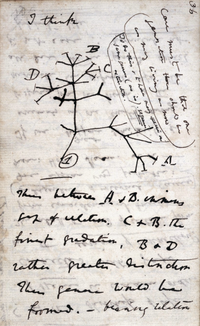- For a less technical and generally accessible introduction to the topic, see Introduction to evolution.
| Part of the Biology series on |
| Evolution |
|---|
 |
| Mechanisms and processes |
| Research and history |
| Evolutionary biology fields |
The mechanisms and processes of evolutionary change includes selection (i.e. natural selection and artificial selection), polyploidy, hybridization, genetic drift, gene flow, and mutation. Natural selection favors genes that improve capacity for survival and reproduction. Genetic drift is random change in the frequency of alleles, caused by the random sampling of a generation's genes during reproduction. Gene flow is the transfer of genes within and between populations. Mutations are changes in the DNA sequence of a cell's genome.
The relative importance of natural selection and genetic drift in a population varies depending on the strength of the selection and the effective population size, which is the number of individuals capable of breeding.[1] Natural selection usually predominates in large populations, while genetic drift dominates in small populations. The dominance of genetic drift in small populations can even lead to the fixation of slightly deleterious mutations.[2] As a result, changing population size can dramatically influence the course of evolution. Population bottlenecks, where the population shrinks temporarily and therefore loses genetic variation, result in a more uniform population.[3] Bottlenecks also result from alterations in gene flow such as decreased migration, expansions into new habitats, or population subdivision.[1]
The outcome of the above mentioned mechanisms can be seen in form of adaptation, speciation and co-evolution. Adaptations are structures or behaviors that enhance a specific function, causing organisms to become better at surviving and reproducing, and speciation is the process where a species diverges into two or more descendant species. Speciation is the process where a species diverges into two or more descendant species and Co-evolution is the mutual evolutionary influence between two species.
- ^ a b Whitlock M (2003). "Fixation probability and time in subdivided populations". Genetics. 164 (2): 767–79. PMID 12807795.
- ^ Ohta T (2002). "Near-neutrality in evolution of genes and gene regulation". PNAS. 99 (25): 16134–37.
- ^ Harwood AJ (1998). "Factors affecting levels of genetic diversity in natural populations". Philos. Trans. R. Soc. Lond., B, Biol. Sci. 353 (1366): 177–86. PMID 9533122.